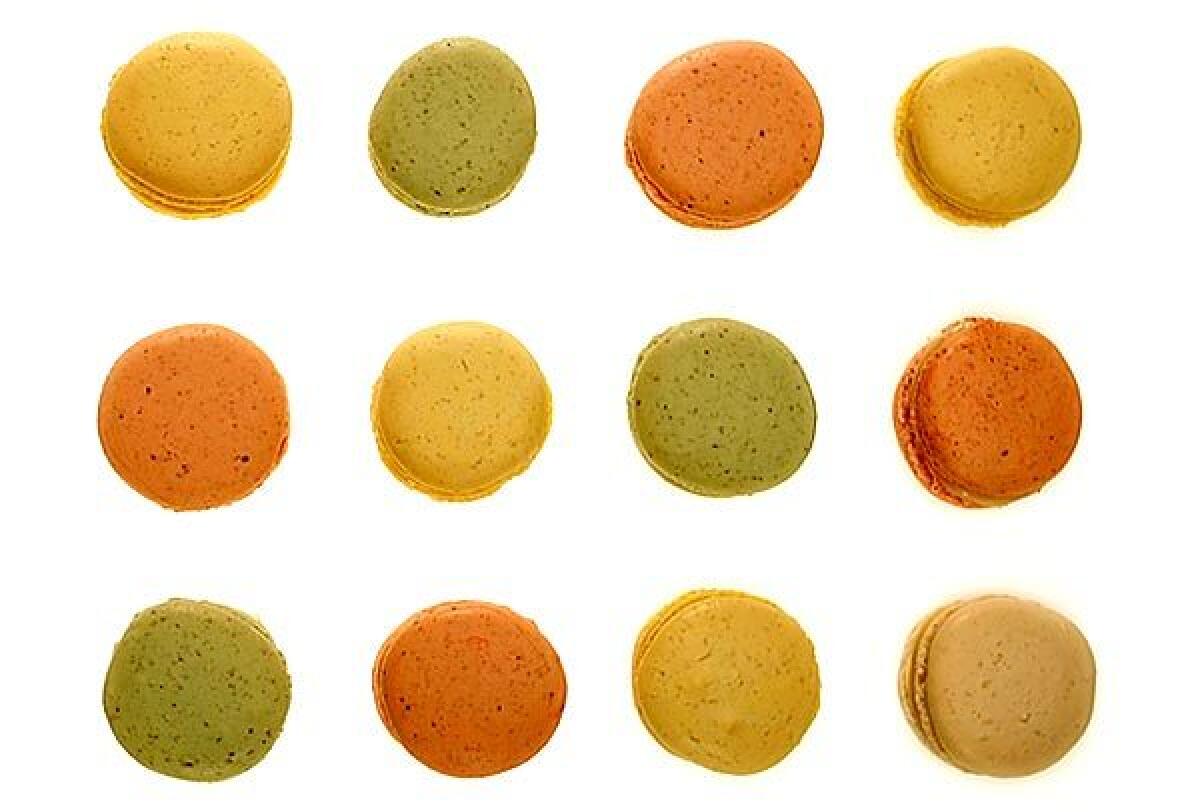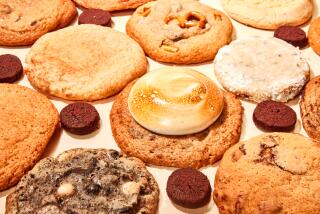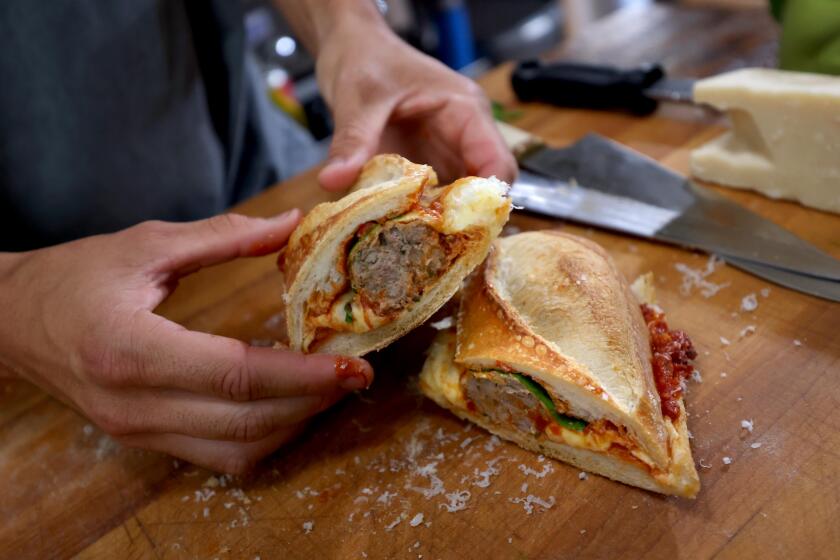Macarons: New to the Easter parade this year

Call me a heretic, but I’ve been thinking it’s about time the Easter Bunny spruced up his product line. Eggs are fine and Peeps are cute, but as Thumper’s 21st century image consultant, I’d advise he hop on the French macaron trend. He wouldn’t even have to change the colors in his paint box: Macarons come in every shade imaginable and some yet to be imagined. And although there’s no chicken-and-egg riddle surrounding them, macarons have their own mysteries.
If there’s another sweet in the canon that’s as beloved, bewitching and bewildering as the macaron, I don’t know it. For me, macarons are an all-around puzzlement, from their name and celebrity to their fabulous colors and surprisingly faint flavors.
And nothing’s quirkier than the way chefs tell us to make them. A quick read through a handful of recipes was enough to convince me that if I didn’t circle the oven three times, rub my magic spatula and leave an offering to the kitchen gods, my macs — and me along with them — would be doomed.
The sweet that I and so many of us are obsessed with these days is le macaron parisien. Like butterflies named for the people who discover them, macarons get named for the city in which they were first made, and Paris gets credit for these. Different cooks have been credited with creating the macaron, but on one point everyone agrees: It was the famed Parisian pastry shop Ladurée that first made them famous, beginning at the turn of the 20th century.
They’re small pastries-cum-cookies, and they’re at once simple and fantastical and nothing at all like their double-O kin, macaroons. What most of us know as a macaroon is usually made with coconut, sometimes almond paste, and it’s sometimes swirly, sometimes round, frequently dense and often tasty, but rarely light, elegant or ooh-la-la worthy.
By contrast, the macaron is a dainty construction in which two cookies — rounded, smooth and crunchy on top, soft and chewy in the middle, and lacily ridged at the base — sandwich something luxurious, like ganache or buttercream.
Faced with one of these fancies for the first time, you might be tempted to do what I did: I deconstructed the thing and ate the parts separately, just the way I’d eat an Oreo. Wrong! Isolate the elements and the magic of the macaron disappears, putting you in jeopardy of having an emperor’s-got-no-clothes experience.
Here’s the thing: The cookie itself doesn’t have much taste. Even though macarons come in a Candyland palette, they all taste pretty much the same because they’re all made from the same ingredients: egg whites, granulated sugar, powdered sugar and ground almonds.
To get the full measure of a macaron, you have to make sure that each bite includes cookies and filling. You get texture from the cookies, but you get flavor from the filling. Pierre Hermé, the roi of pastry in Paris and a man who’s spent years studying the intricacies of macarons, says the filling was his great epiphany. Once he started concentrating on the fillings, he realized that he could extend the macs’ range almost to infinity.
It’s the fillings that allow him to create such flavor combinations as strawberry, rhubarb and passion fruit; olive oil and vanilla; coffee and candied orange; or his most famous, rose, litchi and raspberry. And it’s probably what explains the crowds in his shops. When Hermé creates a new macaron, the news is announced in all the glossies and the lines outside his boutiques are so long you can finish a chunk of “War and Peace” before you reach the door.
Although macarons are becoming more common in America ( Starbucks sold them at Christmas), and even though you can find pluperfect macarons in the U.S. (you’ve got Paulette Macarons in Beverly Hills and François Payard in New York), it’s unlikely the treats will ever be as available as they are in Paris (where you can get them for dessert at McDonald’s).
But it really doesn’t matter because, in the time-honored spirit of do-it-yourself-ism, Americans are taking to their kitchens and making their own macarons, and, to judge from what I see in the blogosphere, pretty beautiful ones too.
Just so you know, a beautiful macaron is one with a lovely, wrinkle-free dome and a craggy circlet around the base, known as the foot. Making beautiful macarons isn’t hard, but it can be fussy and even counterintuitive from time to time, so in addition to a couple of recipes — one made with cooked meringue, the other not — here are a few tips and one piece of advice: Keep that magic spatula handy.
•Old egg whites are better than new; warm is better than cold. At the very least, your egg whites must be at room temperature, but the pros prefer them aged. According to Hermé, you should measure out the whites one week ahead of time, put them in a bowl covered with plastic wrap, poke a few holes in the plastic, then leave them in the fridge to grow old. It’s all about increasing the whites’ elasticity.
•The almond flour and powdered sugar should be as one. Some macaron-makers rub the flour and sugar between their palms, others give them a spin in a mixer and everyone strains the mixture. I go directly to the straining part and then fluff the ingredients with a whisk.
•Beat the meringue until it holds lovely peaks, then stop! You want a meringue that’s just ever so slightly short of holding firm stand-up-and-salute peaks. Above all, you want a meringue that doesn’t lose its gloss.
•Now that you’ve fluffed up the egg whites, stir them down. When the time comes to combine the almond-sugar mixture with the meringue, take off the velvet gloves. Fold the mixtures together, then give the batter a few really stern turns. If the batter doesn’t slide off the spatula like lava (or what you imagine sliding lava to look like), beat it a couple times more.
•Decide on a size and stick to it. While size doesn’t matter, identicalness does. You want the cookies to all be about the same size so they’ll bake evenly and match up nicely when you sandwich them.
•Slam the pan … or don’t. After piping the macarons out onto the baking sheets, some people advise lifting the sheet up and then rapping it against the counter to de-bubble and round the batter; some people don’t. I’ve done it both ways and haven’t seen much difference in the batches, but I slam the sheet nonetheless — mostly because it’s fun.
•Keep cool. Macarons need to be made in a cool, dry place and to rest in that place so they can form a film that doesn’t stick to your fingers when touched.
•At bake time, lay out the offering to the deities. When it’s time to bake the macs, that’s the time to leave a sack of sugar at the cookie goddess’ altar. It’s also the time when chefs seem to get most hocus-pocusy. Some mavens recommend putting the baking sheet with the piped out cookies on top of another pan — it’s what I do — and others don’t. Some bake them at high temperatures, some at low and some at a combination. I’ve tried all the methods and, as you’ll see in the recipes, I settled on two that are only slightly less convoluted.
•Keep even cooler. After the macarons have cooled and you’ve filled them with something luscious, taste one — and then don’t taste another until you’ve covered them and given them a 24-hour rest in the refrigerator. A well-rested macaron is a softer and tastier macaron. Keep the cookies in the fridge and take them out about half an hour before serving.
Greenspan is the author or co-author of eight cookbooks, including “Desserts by Pierre Hermé” and “Chocolate Desserts by Pierre Hermé.”
More to Read
Eat your way across L.A.
Get our weekly Tasting Notes newsletter for reviews, news and more.
You may occasionally receive promotional content from the Los Angeles Times.









